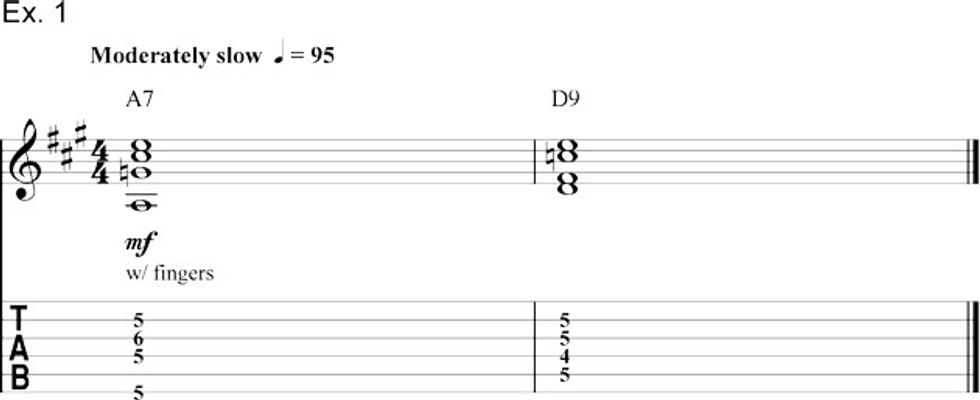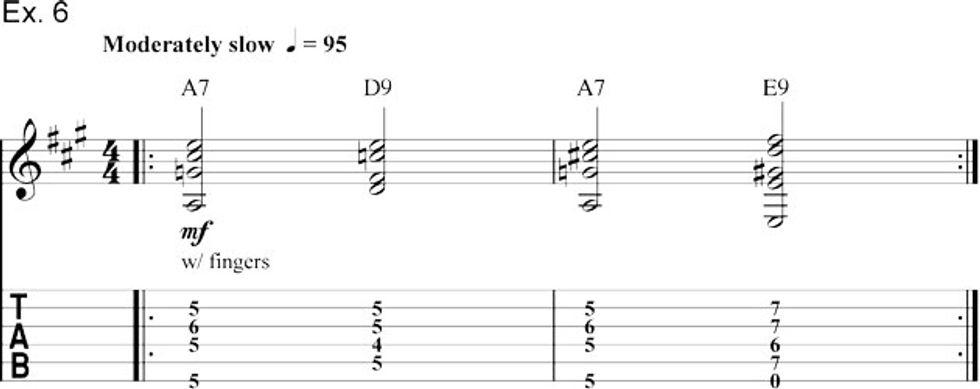Chops: Intermediate
Theory: Intermediate
Lesson Overview:
• Learn how to connect chords with simple bass lines.
• Enhance your comping with chromatic passing tones.
• Refine your hybrid-picking technique.
Click here to download a printable PDF of this lesson's notation.
It’s amazing to watch a guitarist comp jazzy chords while simultaneously laying down a walking bass line. Jazz legend Joe Pass is a pioneer of this style, and for decades guitarists have analyzed and passed around many of his arrangements, songs, and ideas. Other guitar greats, such as Tuck Andress, Leo Kottke, and Charlie Hunter, have continued to explore and develop this compelling technique, which is particularly potent in the context of solo guitar.
For most guitarists, weaving a bass line through changes remains a mystery, so let’s shed some light on the subject. We’ll learn how to move a pattern of single notes on the lower strings while fretting a series of chords on the higher strings. As these two parts move independently, they create the illusion of two musicians playing together at the same time.
We’ll start with Ex.1, which shows a basic A7-D9 (I-IV) chord progression. The same progression appears in Ex. 2, but this time we separate each root from the rest of the chord.

Click here for Ex. 2
The simple process of separating the root from the harmony immediately splits the sound. This provides you with a single bass note and a corresponding chord cluster you can begin to manipulate and move around the neck. To cleanly execute this type of rhythm comping, use a fingerstyle or hybrid (pick and fingers) right-hand technique. It’s difficult to successfully perform walking bass parts using only a flatpick.
The next step of building walking bass lines involves neighbor tones—targeted chromatic notes above or below the root of each chord. Ex. 3 shows how to incorporate lower neighbor tones, while Ex. 4 does the same with upper neighbor tones.
Click here for Ex. 3
Click here for Ex. 4
As your walking ability improves, you can add additional notes to the bass line to fill it out. Ex. 5 recycles our A7-D9 progression, but this time we add several chromatic passing tones to give this phrase a more realistic duo sound.
Click here for Ex. 5
To glean more ideas on how to combine single-note lines and static chords, study a few legendary jazz bassists like Paul Chambers, Jimmy Blanton, and Ron Carter. Each of these masters has a unique approach to creating beautiful lines. This type of research will give you insights into how to play over various progressions, keys, and tempos.
Our next step is to add a third chord to the mix, and Ex. 6 features a common I-IV-I-V turnaround. Common in blues and jazz, turnarounds serve to bring a song back to the beginning, but they can also be used to create a big finale at the end of the song.

Notice how the bass line introduced between the chords in Ex. 7 moves using a neighbor-tone approach with half-step movements between the roots of each chord.
As you play this example, strive for a smooth and connected sound, and be sure to allow the bass notes to ring into the upper chord clusters. Spend time perfecting your movements in both hands because there will be a fair amount of string muting and dampening required to execute this idea. Also take time to appreciate how these two parts work together musically.
Click here for Ex. 7
To enhance the illusion of two musicians performing at once, experiment with dynamics and accents to make the bass notes and chords sound different. Try attacking the bass notes vigorously as you gently pluck the upper chord forms, and then do the reverse.
Now that we’ve expanded the chord progression and walked through a basic turnaround in A, let’s dive into an extended and authentically jazzy chord progression.
As you play through the progression in Ex. 8, notice how many of the root notes lie a whole-step away from each other. This helps to simplify connecting the chord progression with a walking bass line.
Click here for Ex. 8
Once this expanded chord progression feels comfortable under your fingers, it’s time to connect these chords with chromatic passing tones (Ex. 9). Be sure to examine the chord progression and identify the root note and upper portion of each chord as you connect them.
Click here for Ex. 9
While you’re practicing these exercises and riffs, listen to some classic jazz and chord-melody arrangements for inspiration. Once you’re able to use this walking bass concept in your own progressions, try applying the technique to other styles. The more you refine your skills in this area, the more access you’ll have to intriguing musical ideas.


























